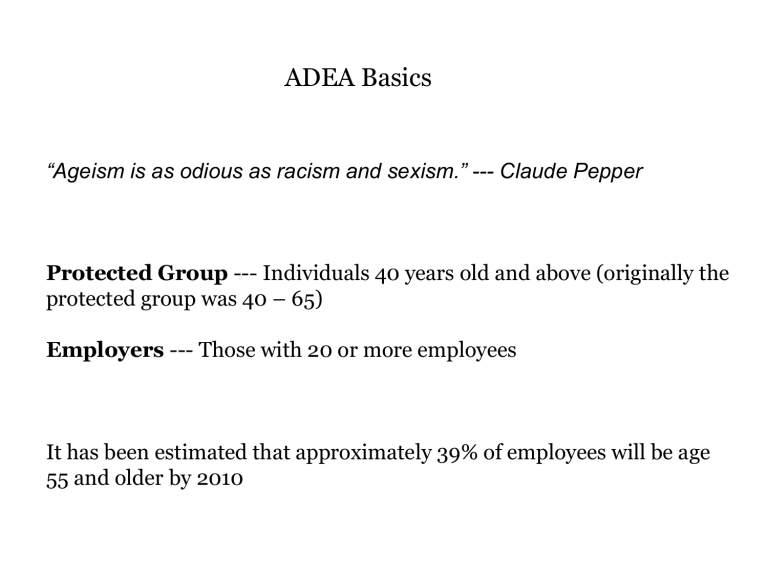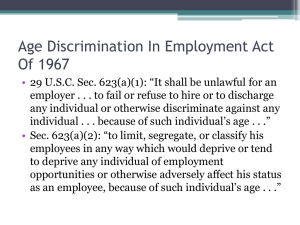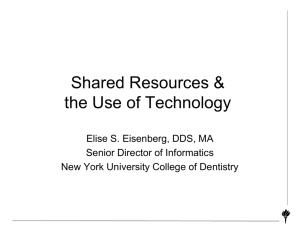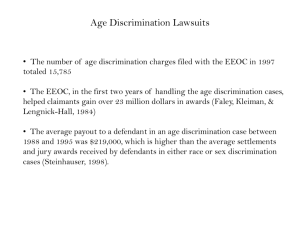ADEA Basics

ADEA Basics
“Ageism is as odious as racism and sexism.” --- Claude Pepper
Protected Group --- Individuals 40 years old and above (originally the protected group was 40 – 65)
Employers --- Those with 20 or more employees
It has been estimated that approximately 39% of employees will be age
55 and older by 2010
~ ADEA Exemptions ~
• Mandatory retirement at age 65 for “bona fide executives” or “high policymaking employees"
• Safety Officers (e.g., police and firefighters) consistent with State and local laws
• Bona fide apprentiship programs (e.g., can refuse to accept those over a given age). Need to be able to show that age at entry is a BFOQ)
• Commercial airlines (pilots and co-pilots 60 years old). Can opt to work in “lesser” capacity such as flight engineers
• Air traffic controllers (those past 30 can be refused for hire; except retired military air traffic controllers). But, they must retire at age 56
• Certain kinds of elected or appointed officials (e.g., State judges)
ADEA’s focus was on the effects of prejudice and stereotypes in limiting the opportunities of older workers (e.g., a belief that job performance edeclines with age)
• Cleveland and Landy (1983) reviewed the gerontology literature and found chronological age not to be a valid predictor of performance for a specific individual in a particular job
• Evidence from a meta-analysis (Waldman & Avolio, 1986) found no significant differences between age groups in objective work performance measures. Rather, the analysis indicated that older workers received lower performance scores when subjective supervisory ratings were used
• Laczko and Philipson (1991) reviewed studies of age effects on job performance and learning ability. It was found that older workers are as productive as younger workers, they are almost as capable of learning (despite less formal education), and have an energy, flexibility, and willingness to learn
~ Sample Ageism Scale Items ~
• Most old people get set in their ways and are unable to change
• It is foolish to claim that wisdom somes with old age
• Most old people tend to let their homes become shabby and unattractive
• Most old people spend too much time prying into the affairs of others and giving unsought advice
• Most old people should be more concerned with their personal appearance; they’re too untidy
• If old people expect to be liked, their first step is to try to get rid of their irritating faults
• Old people have too much power in business and politics
• Most old people make me feel ill at ease
ADEA Burden of Proof Process
Phase 1: Challengers must establish a prima facie case by providing evidence of age discrimination by showing that:
• They are 40 years old or older
• They were qualified for the position in question
• They were victims of an unfavorable employment decision (e.g., not hired, promoted, fired)
• The organization favored an individual who was considerably younger than the challenger
Phase 2: Company must articulate that a legitimate, nondiscriminatory reason exists for their decision
Phase 3: The challenger proves that the organization's reason for their rejection is a pretext for discrimination
BFOQ Defense
1) “That the BFOQ is reasonably necessary to the essence of the business” and
2) “That it has reasonable cause, i.e., a factual basis for believing that all or substantially all persons within the protected age group would be unable to perform safely and efficiently the duties of the job involved, or whether it is impossible or impractical to deal with persons in the protected age group on an individual basis” (Usery v. Tamiami Trail Tours, Inc. 1976, pg. 1241-1242).
Role of Individual Assessment
Western Airlines v. Criswell (1985)
Western Airlines policy forced flight engineers to retire at age 60;
Criswell filed an ADEA suit and met his Phase 1 burden under the ADEA
Phase 2: Western Airlines claimed that age was a BFOQ
• Their primary business was the safe transportation of passengers
• They had a rational basis for believing those over 60 were not qualified
• Testing the ability of all flight engineers age 60 or above was impractical
Supreme Court Decision in Criswell
ADEA intended a BFOQ to be a relatively narrow exception; a lot of individual variation exists
The S. Ct. said that the ADEA indicates a:
“ ... preference for individual evaluation expressed in the language and legislative history of the ADEA. Under the Act, employers are to evaluate employees … on their merits and not their age. In the BFOQ defense,
Congress provided a limited exception to this general principle, but required that employers validate any discrimination as "reasonably necessary to the normal operation of the particular business." It might well be "rational" to require mandatory retirement at any age less than 70, but that result would not comply with Congress' direction that employers must justify the rationale for the age chosen.”
Other problems with Western Airline’s positions were the fact that:
• Other airlines did not require mandatory retirement before age 70
• Western Airlines used individualized tests in other, comparable situations
• The Federal Aviation Administration believed that individualized testing was practical for such jobs.
Criswell won.
Safety Concerns & BFOQ
• Where safety issues of 3rd parties exist (regarding a BFOQ defense) the company: “Must be afforded substantial discretion in selecting specific agerelated standards which, if they err at all, should be on the side of preservation of life and limb” (Tamiami, p. 1243)
• An employer’s burden of showing a BFOQ is “inversely proportional to the degree and unavoidability of the risk to the public or fellow employees inherent in the requirements and duties of a particular job” (Aarin v. Davis, p. 1572).
RFOA Defense (Reasonable Factor Other Than Age)
Organization must show that ots decision was decision was
• “Reasonable” and
• Based on some factor (s) other than age
• Company needs only to articulate clearly the specific nature of the FOA
Reeves v. Sanderson Plumbing Products, Inc
Reeves was fired for poor performance reasons (company position)
Suit filed alleging that this explanation was a pretext for age discrimination
• Formed a prima facie case based on the McDonnell Douglas criteria
• Provided evidence that showed the company’s legitimate reasons for termination were false (lower court said that this did not mean that Reeves has presented sufficient evidence that he had been fired because of his age)
• Recipient of derogatory age-based remarks from his supervisor (lower court said these comments were not made with specific reference to the decision to terminate
Reeves) Use of indirect evidence -
Enough to infer the fact of intentional discrimination
“… a plaintiff ’s prima facie case. Combined with sufficient evidence to find that the employer’s asserted justification is false, may permit the trier of fact to conclude that the employer unlawfully discriminated.”
O'Conner v. Consolidated Coin Caterers (1996)
Brief Facts:
• O’Conner, 67 years old, was replaced him with someone age 40 (i.e., someone in the protected age group)
• The organization said the O’Conner did not establish a prima facie case because he was replaced by an individual who was also in the protected age group
Supreme Court: The ADEA was meant to disallow discrimination because of age . Therefore, the critical evidence for age discrimination in this case was that the person who replaced the fired employee was substantially younger .
“The fact that one person in the protected class has lost out to another person in the protected class is thus irrelevant, so long as he has lost out because of his age. … there can be no greater inference of age discrimination … when a 40 year old is replaced by a 39 year old than when a 56 year old is replaced by a 40 year old. …the fact that a replacement is substantially younger than the plaintiff is a far more reliable indicator of age discrimination than is the fact that the plaintiff was replaced by someone outside the protected class.”
Adverse Impact in the ADEA
• Smith v. City of Jackson (2005
)
Extends coverage of adverse impact into the ADEA, but under different rules than in Title VII
• Meacham v. Knolls Atomic Power (KAPL; 2008)
Addressed a major residual issue from the Smith case
Background on Smith v. City of Jackson
• In 1980s courts treated adverse impact in ADEA with Title VII rules
(e.g., Geller v. Markham, 1980 & Leftwitch v. Harris-Stowe, 1983)
• In Hazen v. Biggens (1993), S.Ct. rules --- employer decisions may be motivated by "factors other than age ... even if the motivating factor is correlated with age."
• 3 Justices also stated that there are good reasons to preclude adverse impact claims in the ADEA
• After Hazen, most circuit courts rule that adverse impact is
unavailable in ADEA as a matter of law, but some court rule otherwise
Hazen v. Biggens (1993)
• Biggens fired after 9 years on the job (10 years needed to be vested in the company’s retirement plan; timing was a few weeks before he was eligible)
• He filed an ADEA suit (age was a determinative factor in the company’s decision)
Regarding an RFOA:
“ ... there is no disparate treatment under the ADEA when the factor motivating the employer is some feature other than the employee's age.”
“ ... a decision by the company to fire an older employee solely because he has nine plus years of service and therefore is "close to vesting" would not constitute discriminatory treatment on the basis of age . The prohibited stereotype
("Older employees are likely to be ___") would not have figured in this decision, and the attendant stigma would not ensue. The decision would not be the result of an inaccurate and denigrating generalization about age, but would rather represent an accurate judgment about the employee--that he indeed is "close to vesting."
“Our holding is simply that an employer does not violate the ADEA just by interfering with an older employee's pension benefits that would have vested by virtue of the employee's years of service.”
Hazen v. Biggens (1993)
Regarding Adverse Impact and the ADEA:
“ ... we have never decided whether a disparate impact theory of liability is available under the ADEA. ... and we need not do so here.”
But, Court ruled in favor of Biggens that the company violated ERISA
Brief Facts in Smith v. City of Jackson
• Police officers and dispatchers with less than 5 years experience get higher percentage increases and those over 40 sue on grounds of adverse impact via ADEA
• Lower courts rules adverse impact is unavailable in ADEA as a matter of law
• Supreme Court takes case to settle split among circuit courts
Supreme Court Ruling in Smith
• In a 5-3 ruling, S.Ct. rules that adverse impact is available in
ADEA
• Adverse impact follows same prima facie (Phase 1) rules in Title VII and ADEA --- Statistical evidence of an identified employment practice that disproportionately excludes protected group members
• Unlike Title VII, which demands proof of job-relatedness & consistency with business necessity (in Phase 2) forcing the plaintiff to prove an equally valid practice with less or no adverse impact (in Phase
3)
• But, the ADEA permits the RFOA defense in Phase 2 forcing plaintiffs to prove that factors advanced are not reasonable (Phase 3)
THUS ------->
GRIGGS-ALBE MARL E (TITLE VII)
Prima Facie
Defense
Pretext
Statistical evidence of an identified emp loyment p ractice that disprop ortionately excl udes protected group members
Proof that the challenged p ractice is job-related and consistent with business necessity
Proof there is an equally valid, job -related practice with less or no adverse impact
SMITH V. CITY OF JACKS ON (ADEA)
Prima Facie
Defense
Pretext
Statistical evidence of an identified emp loyment p ractice that disprop ortionately excl udes protected group members
Proof that the challenged p ractice is sup p orted by a Reasonable
Factor Other Than Age (RFOA)
Proof that the factor cited is unreasonable, or not the true reason for the emp loyment p ractice
Meacham v. KAPL (2004)
[ Before Supreme Court ruling in Smith]
• Over 98% of RIF victims are 40 or older
• KAPL articulates that RIF criteria are (a) criticality of skills and (b) flexibility for retraining as RFOA
• Plaintiffs proved there are alternatives with less adverse impact, including (a) hiring freeze and (b) extension of a voluntary separation plan (VSP) to employees with less than 20 years of service
• Plaintiffs Win
But --------->
Meacham v. KAPL (2006)
After Supreme Court ruling in Smith
• Question is whether RFOA defense affirmative or merely an
articulation that plaintiff must disprove
• All prior rulings involving RFOA have required affirmative proof by defendant; same is true for other statutory defenses (e.g., BFOQ)
• However, 2 Circuit judges favor the productive defense (i.e., articulation -- forcing plaintiffs to prove the articulation is unreasonable, which they cannot
• 3rd judge writes long dissent
>>> Plaintiffs lost 2-1
Supreme Court Ruling in
Meacham v. KAPL
• Supreme Court unanimously agrees with the dissenting judge, listing numerous reasons why statutory defenses such as RFOA
(e.g., Bona Fide Occupational Qualification (BFOQ), Bona Fide
Benefit Plan (BFBP), Bona Fide Seniority System (BFSS)) are affirmative defenses
• Court rules 7–1 that the employer must meet the burden of persuasion (i.e, prove their RFOA, not simply articulate it).
~ Moral of Smith and Meacham ~
• Very hard for plaintiffs to wiqn with factors that are correlated with age (as in Smith)
• However, actual decisions that negatively affect actual employees
(as in a RIF) are problematic for employers (e.g., Meacham)
Recommendation: In a RIF, avoid BS criteria such as “flexibility” and “criticality” unless you can affirmatively prove they are valid criteria
Summary of Key ADEA Cases
Older Workers Benefits Protection Act of 1990
Designed to confront age discrimination in the administration of benefit packages
Special attention was given to voluntary severance or retirement plans (to be eligible for such plans employees are often required to waive their rights to sue for ADEA violations)
Company Requirements Under the OWBPA
• Waivers must be put in writing, be understandable to the average mployee, and references employee rights contained under the ADEA
• Organizations must offer “new” incentives (e.g., benefits, compensation)
• Individual employees must be given 21 days to consider waivers; groups of employees need to be allotted 45 to review waivers
• Employees must have 7 days to rescind a signed agreement





